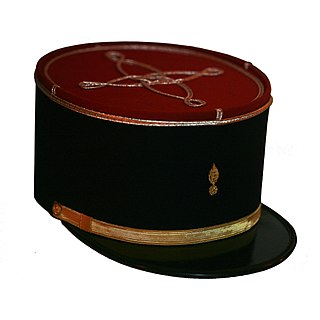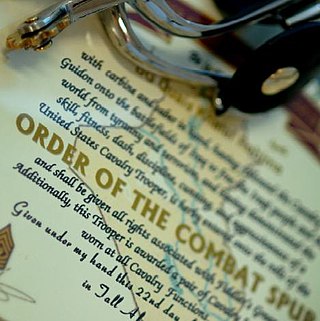
Stetson is an American brand of hat manufactured by the John B. Stetson Company. "Stetson" is also used as a generic trademark to refer to any campaign hat, particularly in Scouting.

The kepi is a cap with a flat circular top and a peak, or visor. In English, the term is a loanword from French: képi, itself a re-spelled version of the Alemannic German: Käppi, a diminutive form of Kappe, meaning 'cap'. In Europe, the kepi is most commonly associated with French military and police uniforms, though versions of it were widely worn by other armies during the late 19th and early 20th centuries. In North America, it is usually associated with the American Civil War, as it was worn by soldiers on both sides of the conflict.

A campaign hat, sometimes called campaign cover, is a broad-brimmed felt or straw hat, with a high crown, pinched symmetrically at the four corners. The campaign hat is occasionally referred to as a Stetson, derived from its origin in the company's Boss of the Plains model in the late 19th century.

A side cap is a military cap that can be folded flat when not being worn. It is also known as a garrison cap or flight cap in the United States, wedge cap in Canada, or field service cap in the United Kingdom; or in vulgar slang as a cunt cap or piss cutter. In form the side cap is comparable to the glengarry, a folding version of the Scottish military bonnet. It has been associated with various military forces since the middle of the 19th century, as well as various civilian organizations.

A peaked cap, peaked hat, service cap, barracks cover, or combination cap is a form of headgear worn by the armed forces of many nations, as well as many uniformed civilian organisations such as law enforcement agencies and fire departments. It derives its name from its short visor, or peak, which was historically made of polished leather but increasingly is made of a cheaper synthetic substitute.

The black beret is a colour of beret, a type of headgear. It is commonly worn by paramilitaries and militaries around the world, particularly armored forces such as the British Army's Royal Tank Regiment (RTR), the Royal Canadian Armoured Corps (RCAC), and Royal Australian Armoured Corps (RAAC) and the Indian Army Armoured Corps and Indian Border Security Force. Notable non-armored military units to wear the black beret include the non-military police and non-special forces elements of the Irish Defence Forces, MOD Guard Service, Russian Naval Infantry and Russian OMON units, the United States Air Force (USAF) Tactical Air Control Party (TACP), Philippine National Police-Special Action Force (PNP-SAF) members, and the Royal Canadian Navy. It was also worn by the United Kingdom's Royal Observer Corps (ROC) with their Royal Air Force (RAF) uniform, Metropolitan Manila Development Authority (MMDA).
Forage cap is the designation given to various types of military undress, fatigue or working headwear. These vary widely in form, according to country or period. The coloured peaked cap worn by the modern British Army for parade and other dress occasions is still officially designated as a forage cap.

Full dress uniform, also known as a ceremonial dress uniform or parade dress uniform, is the most formal type of uniforms used by military, police, fire and other public uniformed services for official parades, ceremonies, and receptions, including private ones such as marriages and funerals. Full dress uniforms typically include full-size orders and medals insignia. Styles tend to originate from 19th century uniforms, although the 20th century saw the adoption of mess dress-styled full-dress uniforms. Designs may depend on regiment or service branch. In Western dress codes, full dress uniform is a permitted supplementary alternative equivalent to the civilian white tie for evening wear or morning dress for day wear – sometimes collectively called full dress – although military uniforms are the same for day and evening wear. As such, full dress uniform is the most formal uniform, followed by the mess dress uniform.

The Order of the Spur is a Cavalry tradition within the United States Army. Soldiers serving with Cavalry units are inducted into the Order of the Spur after successfully completing a "Spur Ride" or for having served during combat as a member of or with a Cavalry unit. A trooper who has earned both Silver and Gold spurs is known as a "Master Spur Holder." Traditionally, each Trooper is presented spurs by his sponsor at a ceremonial dining in commonly referred to as the "Spur Dinner". The spurs are to be worn with the military uniform during Squadron or Regimental ceremonies and events or as designated by the Cavalry unit commander. In some units, gold spurs are awarded for combat inductions while silver spurs represent having completed the Spur Ride. Within the tradition, silver spurs and gold spurs hold a similar relationship for the cavalry as the Expert Infantryman Badge hold in the U.S. Army Infantry, as well as the Expert Field Medical Badge and the Combat Medical Badge hold to U.S. Army Medics. There is no Military Occupational Specialty (MOS) requirement for the Order of the Spur and the order is open to members of foreign militaries serving with U.S. Cavalry units.
This page details the uniforms and insignia of the Israel Defense Forces, excluding rank insignia. For ranks, see Israel Defense Forces ranks and insignia.

The uniforms of the British Army currently exist in twelve categories ranging from ceremonial uniforms to combat dress. Uniforms in the British Army are specific to the regiment to which a soldier belongs. Full dress presents the most differentiation between units, and there are fewer regimental distinctions between ceremonial dress, service dress, barrack dress and combat dress, though a level of regimental distinction runs throughout.

In the United States Army, soldiers may wear insignia to denote membership in a particular area of military specialism and series of functional areas. Army branch insignia is similar to the line officer and staff corps officer devices of the U.S. Navy as well as to the Navy enlisted rating badges. The Medical, Nurse, Dental, Veterinary, Medical Service, Medical Specialist, Chaplains, and Judge Advocate General's Corps are considered "special branches", while the others are "basic branches".

The Army Service Uniform (ASU) is a military uniform for wear by United States Army personnel in garrison posts and at most public functions where the Army Combat Uniform is inappropriate. As of 2021, the Army has two service uniforms for use by its personnel. The Army Green Service Uniform, announced in 2018 and authorized in 2020, is used primarily for daily use in situations where civilians wear business attire, such as office settings or official meetings.

The Royal Air Force uniform is the standardised military dress worn by members of the Royal Air Force. The predominant colours of Royal Air Force uniforms are blue-grey and Wedgwood blue. Many Commonwealth air forces' uniforms are also based on the RAF pattern, but with nationality shoulder flashes. The Royal Air Force Air Cadets wear similar uniforms.

The uniforms of the United States Air Force are the standardized military uniforms worn by members of the United States Air Force to distinguish themselves from the other services.

In the United States (US) military, a beret flash is a shield-shaped embroidered cloth that is typically 2.25 in (5.72 cm) tall and 1.875 in (4.76 cm) wide with a semi–circular base that is attached to a stiffener backing of a military beret. These flashes—a British English word for a colorful cloth patch attached to military headgear—are worn over the left eye with the excess cloth of the beret shaped, folded, and pulled over the right ear giving it a distinctive appearance.
The uniforms of the United States Army distinguish soldiers from other service members. U.S. Army uniform designs have historically been influenced by British and French military traditions, as well as contemporary U.S. civilian fashion trends. The two primary uniforms of the modern U.S. Army are the Army Combat Uniform, used in operational environments, and the Army Green Service Uniform, worn during everyday professional wear and during formal and ceremonial occasions that do not warrant the wear of the more formal blue service uniform.
The military uniforms of the Union Army in the American Civil War were widely varied and, due to limitations on supply of wool and other materials, based on availability and cost of materials. The ideal uniform was prescribed as a dark blue coat with lighter pants, with a black hat. Officer's ranks were denoted with increasing levels of golden decoration. Specific jobs, companies, and units had markedly different styles at times, often following European customs such as that of the Zouaves. Officers uniforms tended to be highly customized and would stray from Army standard. Ironically, several main pieces of gear had been created by order of the U.S. War Secretary Jefferson Davis before the war; he later became Confederate President.
Each branch of the Confederate States armed forces had its own service dress and fatigue uniforms and regulations regarding them during the American Civil War, which lasted from April 12, 1861, until May 1865.

The United States Army has used military berets as headgear with various uniforms beginning in World War II. Since June 14, 2001, a black beret is worn by all U.S. Army troops unless the soldier is approved to wear a different distinctive beret. A maroon beret has been adopted as official headdress by the Airborne forces, a tan beret by the 75th Ranger Regiment, a brown beret by the Security Force Assistance Brigades, and a green beret by the Special Forces.



















